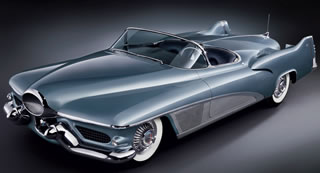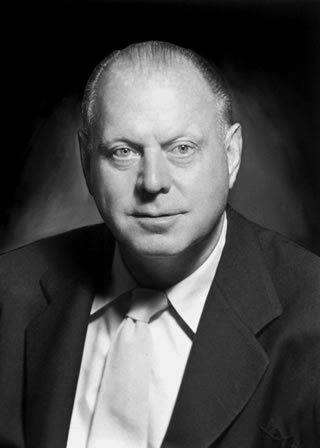Adventure on Wheels
 |
|
|
To Henry Ford, who first mass-marketed them, cars were about getting from place to place—pure function. His cars were black and chunky, year in and year out.
But what are cars really about?
In the 1920s, cars were about pretension—albeit with elegance. With fortress-like hoods, shield-like vertical grilles, In the 1920s, cars were about pretension—albeit with elegance. With fortress-like hoods, shield-like vertical grilles, and teardrop-shaped fenders, Roaring Twenties cars spoke of power and riches.
In the 1930s, cars were about the imagery of speed, as streamlining came to the fore.
By the 1940s it was all about function again as World War II halted production of private vehicles. The last auto rolled off Ford's massive River Rouge plant on February 2, 1942, quickly followed by a B-24 bomber.
Then came the 1950s, when war-weary, car-deprived Americans discovered what cars were really about—fantasy.
To Chris Brown, marketing manager for the Petersen Automotive Museum in Los Angeles, there's nothing better than a mid-century car.
 |
|
|
"These cars were from an optimistic time when the future was bright. It's just like the sense of the houses," he says, referring to Eichler homes and their ilk. "That era of cars is completely different from the era of cars before it and the era of cars after it. It was just the era of free imagination and pushing the boundaries of what was acceptable."
And how car designers did push!
Consider the 1955 Lincoln Futura, a car with fins in the rear and fins in front, and with driver and passenger encapsulated in twin glass canopies.
 |
|
|
And speaking of fins, nothing outdid the Cadillac Eldorado Biarritz from 1959. With its "massive, chrome-edged fins," the car was "the quintessential motoring icon of the 1950s," according to Dennis Adler, author of ''50s Flashback: The American Car.'
Buyers in the 1950s loved their chrome, one of the era's great car designers, Ford's Eugene Bordenat observed, "and we slathered them with it."
But mid-century designers could be subtle as well. Take a look at the Chevrolet Biscayne from 1955, a sexy little sports car with curves in just the right places.
Not surprisingly, the most fantastic '50s cars, including the Lincoln Futura, are 'dream cars,' also known as 'concept' or 'idea cars,' built as experiments and as marketing devices.
"An 'idea car' may cost a fortune to build," the 'Los Angeles Times' observed in 1963, "but if people hate the beast, it may well save the company from a multi-million dollar production car disaster."
 |
|
|
Dream cars, usually shown to the public at annual shows, ranged from the why-didn't they-put this-into-production dreams to the thank-god-they-never-put-this-into-production nightmares.
Among the dreams is the sleek, strikingly bronze-colored Chrysler Turbine, a turbine-powered car from 1963 with a subtle taper to the rear. It was a spare design by Elwood Engel, who had earlier worked on the similarly styled Ford Thunderbird. Its turbine engine would last almost forever and run on almost anything, Brown says, but threw off enough heat to scald anyone in its wake.
Too bad—because it was a beautiful car.




